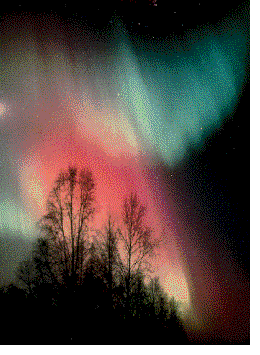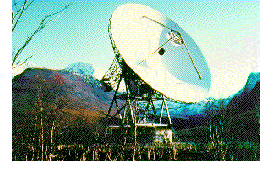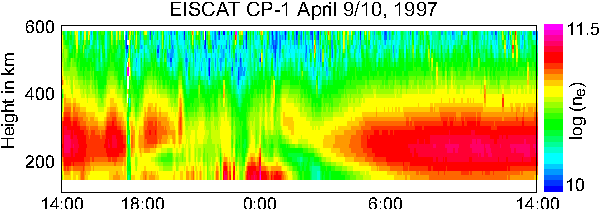
|
EISCAT
|
 |

|
EISCAT
|
 |
| Science objectives of the Eiscat experiment | |
| Eiscat publications by MPS members |
 This part of the upper
This part of the upper
![]() atmosphere of our planet Earth
is one of the most exciting regions. Ranging from about 90 km to several
1000 km altitude it contains phenomena like the beautiful visible aurora,
high current streams of several 100000 A (auroral electrojet), heating due to
particles and currents and changes in ion composition and motion. It is
unique compared to other ionospheric regions on Earth, since the magnetic
field lines originating here stretch out far into the tail of the
magnetosphere (sometimes even into interstellar space). Along these field
lines high energetic electrons and protons are accellerated towards the Earth
moving in spiral orbits. These particles cause several of the effects
mentioned above. In addition, high electric fields are present which are
primarily caused by the solar wind, flowing past the magnetosphere. Many
phenomena in the high latitude ionosphere (geographic latitude between about
60 and 75 degrees) are still poorly understood.
atmosphere of our planet Earth
is one of the most exciting regions. Ranging from about 90 km to several
1000 km altitude it contains phenomena like the beautiful visible aurora,
high current streams of several 100000 A (auroral electrojet), heating due to
particles and currents and changes in ion composition and motion. It is
unique compared to other ionospheric regions on Earth, since the magnetic
field lines originating here stretch out far into the tail of the
magnetosphere (sometimes even into interstellar space). Along these field
lines high energetic electrons and protons are accellerated towards the Earth
moving in spiral orbits. These particles cause several of the effects
mentioned above. In addition, high electric fields are present which are
primarily caused by the solar wind, flowing past the magnetosphere. Many
phenomena in the high latitude ionosphere (geographic latitude between about
60 and 75 degrees) are still poorly understood.
 Our main tool for investigations is the incoherent scatter technique.
In this method, high power (around 1 MW) radio pulses are transmitted
into the ionosphere with large antennas. A tiny fraction of the emitted
power is scattered back and received with the same antennas. The scatter
takes place at thermal fluctuations of the ionospheric electron gas.
Therfore mainly informations about the ionospheric electrons can be
obtained. But since these electrons are electrostatically coupled to the
ions, we can also measure ion properties.
Our main tool for investigations is the incoherent scatter technique.
In this method, high power (around 1 MW) radio pulses are transmitted
into the ionosphere with large antennas. A tiny fraction of the emitted
power is scattered back and received with the same antennas. The scatter
takes place at thermal fluctuations of the ionospheric electron gas.
Therfore mainly informations about the ionospheric electrons can be
obtained. But since these electrons are electrostatically coupled to the
ions, we can also measure ion properties.
In general four parameters can be obtained with the incoherent scatter technique:

Example of EISCAT electron density data
The height and time resolution of the method is about 1 kilometer and 1 minute, respectively. Many other ionospheric quantities can be estimated with the above parameters, like conductivities, currents, heating rates, electric fields, travelling ionospheric disturbances (TIDs).
We use the incoherent scatter facilities of
![]() EISCAT, a multi-national organisation to study the high latitude
ionosphere. It operates several of the most modern and most advanced
incoherent scatter radars, located in Norway, Sweden, Finland and on Svalbard
(Spitzbergen).
EISCAT, a multi-national organisation to study the high latitude
ionosphere. It operates several of the most modern and most advanced
incoherent scatter radars, located in Norway, Sweden, Finland and on Svalbard
(Spitzbergen).
Some studes which have been performed in the past years are:
| © 2006, Max-Planck-Institut für Sonnensystemforschung, Lindau |
Schlegel 09-11-2001 |